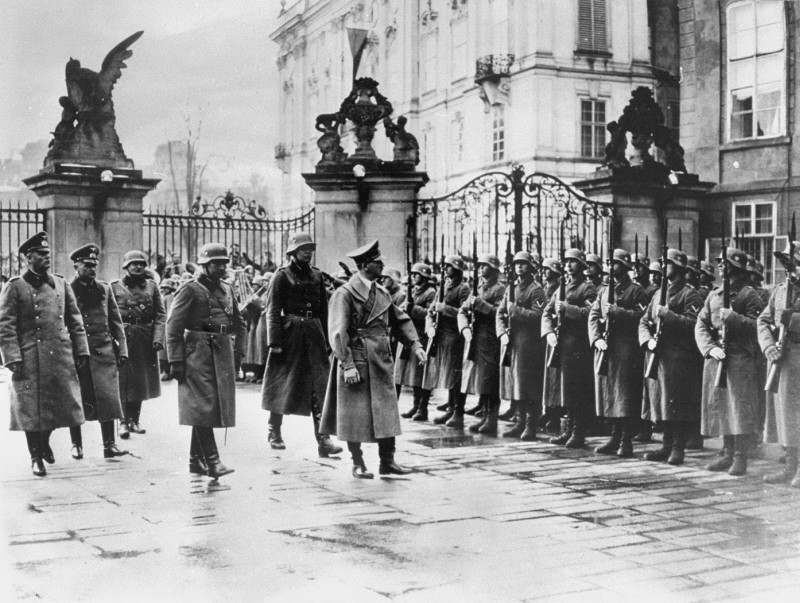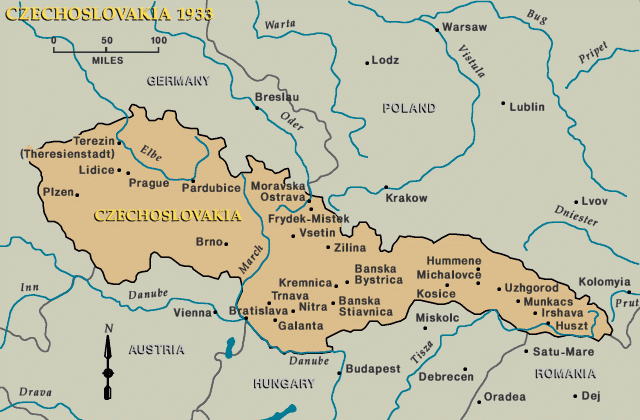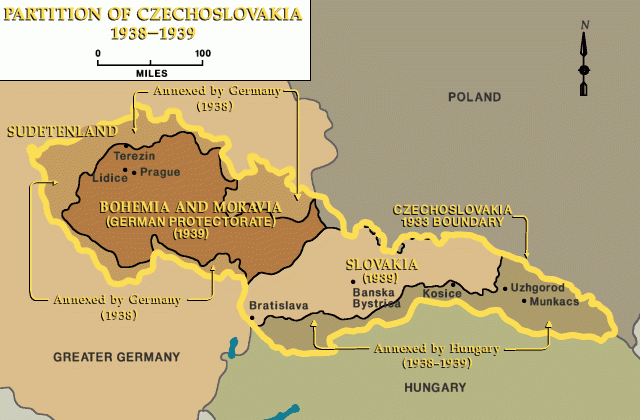
Czechoslovakia

Czechoslovakia was founded in 1918 after the dissolution of the Austro-Hungarian state at the end of World War I. It included the Czech provinces of Bohemia and Moravia, Slovakia, the province of Subcarpathian Rus (Transcarpathian Ukraine), and portions of Austrian Silesia.
Prewar census data divides the prewar population of Czechoslovakia along ethnic (mother tongue) lines at about 50 percent Czech, 22.3 percent German, 16 percent Slovak, 4.78 percent Magyar (Hungarian), 3.79 percent Ukrainian, 1.29 Hebrew and Yiddish, and 0.57 Polish.
Despite its multinational population and tense relations with its neighbors, all of whom coveted its territory, Czechoslovakia remained a functioning parliamentary democracy until the Munich crisis of 1938.
Annexation of the Sudetenland

After the Nazi seizure of power in 1933, Germany demanded the “return” of the ethnic German population of Czechoslovakia—and the land on which it lived—to the German Reich. In late summer 1938, Hitler threatened to unleash a European war unless the Sudetenland was ceded to Germany. The Sudetenland was a border area of Czechoslovakia containing a majority ethnic German population as well as all of the Czechoslovak Army's defensive positions in event of a war with Germany. The leaders of Britain, France, Italy, and Germany held a conference in Munich on September 29–30, 1938. In what became known as the Munich Pact, they agreed to the German annexation of the Sudetenland in exchange for a pledge of peace from Hitler.
Partition of Czechoslovakia
In the wake of the Munich Pact, the leaders of the democratic government in Czechoslovakia resigned; President Beneš left the country for France. Under severe German pressure and Slovak separatist pressure from within, the rump state restructured itself into an authoritarian regime and renamed itself Czecho-Slovakia, reflecting the significant autonomy granted to Slovakia. These efforts did nothing to deter Nazi Germany from inviting Czechoslovakia's other neighbors to make demands on its territory. In the autumn of 1938, as a result of the First Vienna Arbitration Award, Hungary annexed territory in southern Slovakia, and Poland annexed the Tešin District of Czech Silesia.

On March 15, 1939, Nazi Germany invaded and occupied the Czech provinces of Bohemia and Moravia in the rump Czecho-Slovak state, in flagrant violation of the Munich Pact. The German occupation authorities refashioned the two provinces as a German protectorate, annexed directly to the Reich, but under the leadership of a Reich Protector. Konstantin von Neurath, the former German foreign minister, served as Reich Protector from March 1939 until he was replaced by RSHA chief Reinhard Heydrich. After Heydrich's assassination in late spring 1942, Order Police chief Kurt Daluege served briefly as Reich Protector. From 1943 until 1945, former Minister of the Interior Wilhelm Frick held this post.
Slovakia became an independent state under the leadership of a Catholic priest, Jozef Tiso, whose followers established a fascist, authoritarian, one-party dictatorship, strongly influenced by the separatist Catholic clerical hierarchy in internal policy and closely allied with Nazi Germany. The ruling party was the Slovak People's Party. The Tiso regime remained in power until April 1945.
In March 1939, Hungary seized and annexed Subcarpathian Rus. Established as a new state in 1918, Czechoslovakia had disappeared from the map two decades later.
The Germans and their collaborators killed approximately 263,000 Jews who had resided on the territory of the Czechoslovak Republic in 1938.
Items 1 through 1 of 2
Critical Thinking Questions
- Investigate the history of Jews in the territory that became Czechoslovakia.
- How did the world and world leaders respond to the partition and later annexation of Czechoslovakia?
- How and why was the principle of national sovereignty ignored or overruled?

















